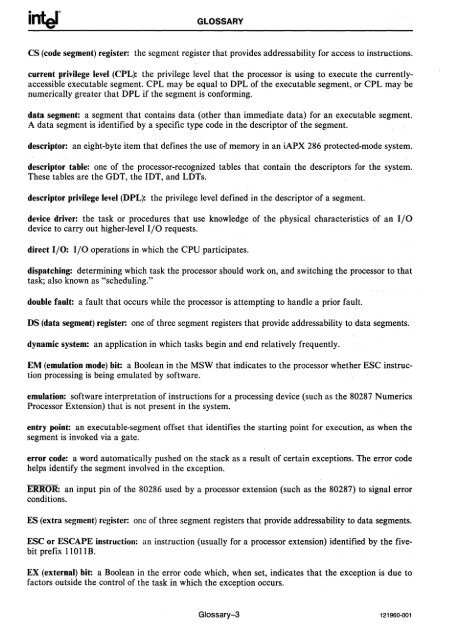iAPX 286 Operating System Writers Guide 1983
iAPX 286 Operating System Writers Guide 1983
iAPX 286 Operating System Writers Guide 1983
You also want an ePaper? Increase the reach of your titles
YUMPU automatically turns print PDFs into web optimized ePapers that Google loves.
GLOSSARYCS (code segment) register: the segment register that provides addressability for access to instructions.current privilege level (CPL): the privilege level that the processor is using to execute the currentlyaccessibleexecutable segment. CPL may be equal to DPL of the executable segment, or CPL may benumerically greater that DPL if the segment is conforming.data segment: a segment that contains data (other than immediate data) for an executable segment.A data segment is identified by a specific type code in the descriptor of the segment.descriptor: an eight-byte item that defines the use of memory in an <strong>iAPX</strong> <strong>286</strong> protected-mode system.descriptor table: one of the processor-recognized tables that contain the descriptors for the system;These tables are the GDT, the IDT, and LDTs.descriptor privilege level (DPL): the privilege level defined in the descriptor of a segment.device driver: the task or procedures that use knowledge of the physical characteristics of an I/Odevice to carry out higher-level I/0 requests.direct I/O: I/O operations in which the CPU participates.dispatching: determining which task the processor should work on, and switching the processor to thattask; also known as "scheduling."double fault: a fault that occurs while the processor is attempting to handle a prior fault.DS (data segment) register: one of three segment registers that provide addressability to data segments.dynamic system: an application in which tasks begin and end relatively frequently.EM (emulation mode) bit: a Boolean in the MSW that indicates to the processor whether ESC instructionprocessing is being emulated by software.emulation: software interpretation of instructions for a processing device (such as the 80287 NumericsProcessor Extension) that is not present in the system.entry point: an executable-segment offset that identifies the starting point for execution, as when thesegment is invoked via a gate.error code: a word automatically pushed on the stack as a result of certain exceptions. The error codehelps identify the segment involved in the exception.ERROR: an input pin of the 80<strong>286</strong> used by a processor extension (such as the 80287) to signal errorconditions.ES (extra segment) register: one of three segment registers that provide addressability to data segments.ESC or ESCAPE instruction: an instruction (usually for a processor extension) identified by the fivebitprefix 110118.EX (external) bit: a Boolean in the error code which, when set, indicates that the exception is due tofactors outside the control of the task in which the exception occurs.Glossary-3 121960·001
















